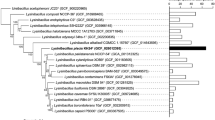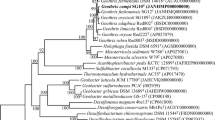Abstract
A novel bacterial strain, designated 17J68-15T, was isolated from dry soil collected in Jeju Island, South Korea. Cells of strain 17J68-15T are Gram-negative, pale-yellow-colored, non-motile, non-spore-forming, rod-shaped was able to grow at 18–42 °C with 0–1% NaCl on R2A agar. Phylogenetic analysis based on the 16S rRNA gene sequence revealed that the strain was distinct from any previously known species of the genus Flaviaesturariibacter. The highest degrees of 16S rRNA gene sequence similarity found with Flaviaesturariibacter terrae HY03T (97.6%), Flaviaesturariibacter amylovorans (96.2%) and Flaviaesturariibacter luteus AW305T (96.0%). The DNA G + C content of the novel strain, 17J68-15T, was 9.3 mol%. Chemotaxonomic data revealed that the major fatty acids were iso-C15:0, iso-C15:1 G, iso-C17:0 3-OH and summed feature 3 (C16:1 ω6c and/or C16:1 ω7c); the major polar lipid was identified as phosphatidylethanolamine, and the major quinone was identified as MK-7. Based on polyphasic characterization, strain 17J68-15T represents a novel species of the genus Flaviaesturariibacter for which the name Flaviaesturariibacter aridisoli sp. nov. is proposed, with the type strain 17J68-15T (= KCTC 62220T = JCM 19635T).

Similar content being viewed by others
References
Kämpfer P, Lodders N, Falsen E (2011) Hydrotalea flava gen. nov., sp. nov., a new member of the phylum Bacteroidetes and allocation of the genera Chitinophaga, Sediminibacterium, Lacibacter, Flavihumibacter, Flavisolibacter, Niabella, Niastella, Segetibacter, Parasegetibacter, Terrimonas, Ferruginibacter, Filimonas and Hydrotalea to the family Chitinophagaceae fam. nov. Int J Syst Evol Microbiol 61:518–523
Kang JY, Chun J, Seo JW, Kim CH, Jahng KY (2015) Flaviaesturariibacter amylovorans gen. nov., sp. nov., a starch-hydrolysing bacterium, isolated from estuarine water. Int J Syst Evol Microbiol 65:2209–2214
Oren A (2017) Proposal to correct the generic name Flaviaesturariibacter Kang, Chun, Seo, Kim and Jahng 2015, 2212 to Flavaestuariibacter. Request Opin 67:3686–3686
Pascual J, Foesel BU, Geppert A, Huber KJ, Overmann J (2017) Flaviaesturariibacter luteus sp. nov., isolated from an agricultural floodplain soil, and emended description of the genus Flaviaesturariibacter. Int J Syst Evol Microbiol 67:1727–1734
Okiria J, Lee JJ, Park SJ, Lee YH, Lee SY, Park S, Kim BO, Ten LN, Jung HY (2017) Flaviaesturariibacter terrae sp. nov., isolated from mountain soil. Int J Syst Evol Microbiol 67:2660–2664
Jang JH, Maeng SH, Jung HY, Kim MK, Subramani G (2020) Flaviaesturariibacter flavus sp. nov., isolated from soil in Jeju Island. Arch Microbiol 202:2663–2669
Yoon MH, Im WT (2007) Flavisolibacter ginsengiterrae gen. nov., sp. nov. and Flavisolibacter ginsengisoli sp. nov., isolated from ginseng cultivating soil. Int J Syst Evol Microbiol 57:1834–1839
Zhao R, Chen XY, Li XD, Tian Y, Kong BH, Chen ZL, Li YH (2014) Cnuella takakiae gen. nov., sp. nov., a member of the phylum Bacteroidetes isolated from Takakia lepidozioides. Int J Syst Evol Microbiol 64:607–612
Weisburg WG, Barns SM, Pellerier DA, Lane DJ (1999) 16S ribosomal DNA amplification for phylogenetic study. J Bacteriol 173:697–703
Yoon SH, Ha SM, Kwon S, Lim J, Kim Y, Seo H, Chun J (2017) Introducing EzBioCloud: a taxonomically united database of 16S rRNA and whole genome assemblies. Int J Syst Evol Microbiol 67:1613–1617
Hall TA (1999) BioEdit: a user-friendly biological sequence alignment editor and analysis program for Windows 95/98/NT. Nucleic Acids Symp Ser 41:95–98
Thompson JD, Gibson TJ, Plewniak F, Jeanmougin F, Higgins DG (1997) The clustal X windows interface: flexible strategies for multiple sequence alignment aided by quality analysis tools. Nucleic Acids Res 24:4876–4882
Tamura K, Stecher G, Kumar S (2011) MEGA7: molecular evolutionary genetics analysis version 7.0 for bigger datasets. Mol Biol Evol 33:1870–1874
Saitou N, Nei M (1987) The neighbor-joining method: a new method for reconstructing phylogenetic trees. Mol Biol Evol 4:406–425
Felsenstein J (1981) Evolutionary trees from DNA sequences: a maximum likelihood approach. J Mol Evol 17:368–376
Kimura M (1980) A simple method for estimating evolutionary rates of base substitutions through comparative studies of nucleotide sequences. J Mol Evol 16:111–120
Felsenstein J (1985) Confidence limit on phylogenies: an approach using the bootstrap. Evolution 39:783–791
Bankevich A, Nurk S, Antipov D, Gurevich AA, Dvorkin M, Kulikov AS, Lesin VM, Nikolenko SI, Pham S, Prjibelski AD, Pyshkin AV, Sirotkin AV, Vyahhi N, Tesler G, Alekseyev MA, Pevzner PA (2012) SPAdes: a new genome assembly algorithm and its applications to single-cell sequencing. J Comput Biol 19:455–477
Tatusova T, DiCuccio M, Badretdin A, Chetvernin V, Nawrocki EP, Zaslavsky L, Lomsadze A, Pruitt KD, Borodovsky M, Ostell J (2016) NCBI prokaryotic genome annotation pipeline. Nucleic Acids Res 44:6614–6624
Lee I, Kim YO, Park SC, Chun J (2015) OrthoANI: an improved algorithm and software for calculating average nucleotide identity. Int J Syst Evol Microbiol 66:1100–1103
Cappuccino JG, Sherman N (2002) Microbiology—a laboratory manual, 6th edn. Pearson Education, Inc., Benjamin Cummings, CA
Minnikin DE, O’Donnell AG, Goodfellow M, Alderson G, Athalye M, Schaal A, Parlett JH (1984) An integrated procedure for the extraction of bacterial isoprenoid quinones and polar lipids. J Microbiol Method 2:233–241
Komagata K, Suzuki K (1987) Lipid and cell-wall analysis in bacterial systematics. Methods Microbiol 19:161–207
Collins M, Dorsch M, Stackebrandt E (1989) Transfer of Pimelobacter tumescens to Terrabacter gen. nov. as Terrabacter tumescens comb. nov. and of Pimelobacter jensenii to Nocardioides as Nocardioides jensenii comb. nov. Int J Syst Bacteriol 39:1–6
Shin YK, Lee JS, Chun CO, Kim HJ, Park YH (1996) Isoprenoid quinone profiles of Leclercia adecarboxylata KCTC 1036T. J Microbiol Biotechnol 6:68–69
Sasser M (1990) Identification of bacteria by gas chromatography of cellular fatty acids. MIDI Technical Note 101. MIDI Inc, Newark, DE
Hiraishi A, Ueda Y, Ishihara J, Mori T (1996) Comparative lipoquinone analysis of influent sewage and activated sludge by high performance liquid chromatography and photodiode array detection. J Gen Appl Microbiol 42:457–469
Acknowledgements
This research was supported by the research grant from Seoul Women’s University (2021), and MISP (Ministry of Science, ICT & Future Planning), Korea, under the National Program for Excellence in SW supervised by the IITP (Institute of Information & communications Technology Planning & Evaluation)” (2016-0-00022) and by a grant from the National Institute of Biological Resources (NIBR), funded by the Ministry of Environment (MOE) of the Republic of Korea (NIBR201801204).
Author information
Authors and Affiliations
Corresponding author
Ethics declarations
Conflict of interest
The authors declare that there are no conflicts of interest.
Ethical Approval
This article does not contain any studies with human participants or animals.
Additional information
Publisher's Note
Springer Nature remains neutral with regard to jurisdictional claims in published maps and institutional affiliations.
The GenBank accession numbers of Flaviaesturariibacter aridisoli are MK101063 (16S rRNA gene), and NZ_SKFH00000000 (draft genome sequence).
Supplementary Information
Below is the link to the electronic supplementary material.
Rights and permissions
About this article
Cite this article
Lee, S.E., Han, J.H., Sathiyaraj, G. et al. Flaviaesturariibacter aridisoli sp. nov., A Bacterium Isolated from Dry Soil. Curr Microbiol 78, 837–842 (2021). https://doi.org/10.1007/s00284-020-02312-9
Received:
Accepted:
Published:
Issue Date:
DOI: https://doi.org/10.1007/s00284-020-02312-9




